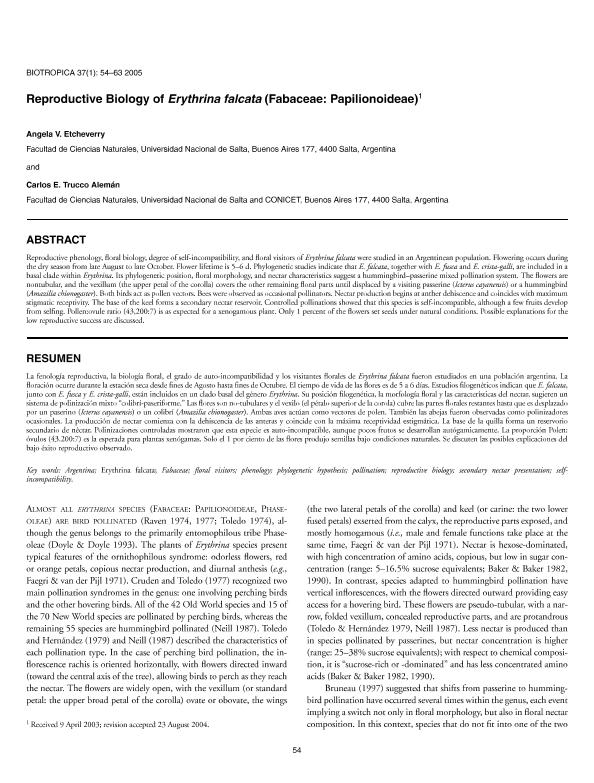Mostrar el registro sencillo del ítem
dc.contributor.author
Etcheverry, Angela Virginia

dc.contributor.author
Trucco Aleman, Carlos Eduardo

dc.date.available
2020-01-10T18:43:19Z
dc.date.issued
2005-03
dc.identifier.citation
Etcheverry, Angela Virginia; Trucco Aleman, Carlos Eduardo; Reproductive biology of Erythrina falcata (Fabaceae: Papilionoideae); Wiley Blackwell Publishing, Inc; Biotropica; 37; 1; 3-2005; 54-63
dc.identifier.issn
0006-3606
dc.identifier.uri
http://hdl.handle.net/11336/94325
dc.description.abstract
Reproductive phenology, floral biology, degree of self-incompatibility, and floral visitors of Erythrina falcata were studied in an Argentinean population. Flowering occurs during the dry season from late August to late October. Flower lifetime is 5-6 d. Phylogenetic studies indicate that E. falcata, together with E. fusca and E. crista-galli, are included in a basal clade within Erythrina. Its phylogenetic position, floral morphology, and nectar characteristics suggest a hummingbird-passerine mixed pollination system. The flowers are nontubular, and the vexillum (the upper petal of the corolla) covers the other remaining floral parts until displaced by a visiting passerine (Icterus cayanensis) or a hummingbird (Amazilia chionogaster). Both birds act as pollen vectors. Bees were observed as occasional pollinators. Nectar production begins at anther dehiscence and coincides with maximum stigmatic receptivity. The base of the keel forms a secondary nectar reservoir. Controlled pollinations showed that this species is self-incompatible, although a few fruits develop from selfing. Pollen:ovule ratio (43,200:7) is as expected for a xenogamous plant. Only 1 percent of the flowers set seeds under natural conditions. Possible explanations for the low reproductive success are discussed.
dc.format
application/pdf
dc.language.iso
eng
dc.publisher
Wiley Blackwell Publishing, Inc

dc.rights
info:eu-repo/semantics/openAccess
dc.rights.uri
https://creativecommons.org/licenses/by-nc-sa/2.5/ar/
dc.subject
ARGENTINA
dc.subject
ERYTHRINA FALCATA
dc.subject
FABACEAE
dc.subject
FLORAL VISITORS
dc.subject
PHENOLOGY
dc.subject
PHYLOGENETIC HYPOTHESIS
dc.subject
POLLINATION
dc.subject
REPRODUCTIVE BIOLOGY
dc.subject
SECONDARY NECTAR PRESENTATION
dc.subject
SELF-INCOMPATIBILITY
dc.subject.classification
Biología Reproductiva

dc.subject.classification
Ciencias Biológicas

dc.subject.classification
CIENCIAS NATURALES Y EXACTAS

dc.title
Reproductive biology of Erythrina falcata (Fabaceae: Papilionoideae)
dc.type
info:eu-repo/semantics/article
dc.type
info:ar-repo/semantics/artículo
dc.type
info:eu-repo/semantics/publishedVersion
dc.date.updated
2019-07-31T18:56:51Z
dc.journal.volume
37
dc.journal.number
1
dc.journal.pagination
54-63
dc.journal.pais
Reino Unido

dc.journal.ciudad
Londres
dc.description.fil
Fil: Etcheverry, Angela Virginia. Universidad Nacional de Salta; Argentina
dc.description.fil
Fil: Trucco Aleman, Carlos Eduardo. Consejo Nacional de Investigaciones Científicas y Técnicas; Argentina. Universidad Nacional de Salta; Argentina
dc.journal.title
Biotropica

dc.relation.alternativeid
info:eu-repo/semantics/altIdentifier/doi/http://dx.doi.org/10.1111/j.1744-7429.2005.03053.x
dc.relation.alternativeid
info:eu-repo/semantics/altIdentifier/url/https://onlinelibrary.wiley.com/doi/full/10.1111/j.1744-7429.2005.03053.x
Archivos asociados
